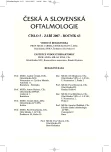-
Medical journals
- Career
Transcorneal and Transscleral Iontophoresis of the Dexamethasone Phosphate into the Rabbit Eye
Authors: F. Raiskup-Wolf 1; E. Eljarrat-Binstock 2; M. Rehák 3; A. Domb 2; J. Frucht-Pery 4
Authors‘ workplace: Očná klinika, Fakultná nemocnica Univerzity Drážďany, Nemecko prednosta prof. Dr. med. Lutz E. Pillunat 1; Oddelenie lekárskej chémie a prírodných výrobkov, Lekárska fakulta Hebrejská univerzita, Jeruzalem, Izrael prednosta prof. Avi Domb, PhD. 2; Očná klinika, Fakultná nemocnica Univerzity Lipsko, Nemecko prednosta prof. Dr. med. Peter Wiedemann 3; Očná klinika, Fakultná nemocnica Hadassah, Jeruzalem, Izrael prednosta prof. Jacob Pe`er, M. D. 4
Published in: Čes. a slov. Oftal., 63, 2007, No. 5, p. 360-368
Overview
Purpose:
To evaluate the efficiency of the dexamethasone phosphate penetration into the rabbit eye after transcorneal and transscleral iontophoresis using a drug loaded hydrogel assembled on a portable iontophoretic Mini Ion device.Methods:
Iontophoresis of dexamethasone phosphate was studied in healthy rabbits using drug-loaded disposable HEMA hydrogel sponges and portable iontophoretic device. Corneal iontophoretic administration was performed with electric current of 1 mAmp for 1, 2, and 4 min. In the control group, the dexamethasone was applied in drops into the conjunctival sac. Transconjunctival and transscleral iontophoresis were performed in the pars plana area, through the conjunctiva or directly on the sclera. Dexamethasone concentrations were assayed using HPLC method. To study the anatomical changes after iontophoresis application, histological examinations of corneas excised 5 minutes and 8 hours after the procedure were performed.Results:
Dexamethasone levels in the rabbits’ corneas after a single transcorneal iontophoresis were up to 38 times higher compared to those obtained after topical eye drops instillation. High drug concentrations were obtained in the retina and sclera 4 hours after transscleral iontophoresis as well. There were no statistically significant differences in the drug concentration after transscleral and tranconjunctival iontophoresis. Histological examination of the corneas after the iontophoresis showed only discrete reversible changes of the epithelium and the stroma.Conclusion:
A short, low-current, non-invasive iontophoretic treatment using the dexamethasone-loaded hydrogels has a potential clinical value in increasing the drug’s penetration into the anterior and posterior segment of the eye.Key words:
iontophoresis, hydrogels, dexamethasone phosphate, concentration of the drug, toxicity
Labels
Ophthalmology
Article was published inCzech and Slovak Ophthalmology

2007 Issue 5-
All articles in this issue
- The Treatment of the Exsudative Age-Related Macular Degeneration with Choroidal Neovascular Membrane, its Possibilities and Economical Indexes
- Intraocular Pressure (IOP) in Rabbits after Application of Amino Acids Taurine and Arginine with Betablocker Timolol
- The Importance of HRT II and Perimeter Octopus 101 in Glaucoma Diseases
- Importance of Structural Examination Methods in the Follow-up of Patients with Ocular Hypertension
- Transmissing Electron Microscopy of the Vitreo-Macular Border in Clinically Significant Diabetic Macular Edema
- First Experiences with the Visante Apparatus
- Transcorneal and Transscleral Iontophoresis of the Dexamethasone Phosphate into the Rabbit Eye
- Czech and Slovak Ophthalmology
- Journal archive
- Current issue
- Online only
- About the journal
Most read in this issue- The Importance of HRT II and Perimeter Octopus 101 in Glaucoma Diseases
- Importance of Structural Examination Methods in the Follow-up of Patients with Ocular Hypertension
- Transcorneal and Transscleral Iontophoresis of the Dexamethasone Phosphate into the Rabbit Eye
- The Treatment of the Exsudative Age-Related Macular Degeneration with Choroidal Neovascular Membrane, its Possibilities and Economical Indexes
Login#ADS_BOTTOM_SCRIPTS#Forgotten passwordEnter the email address that you registered with. We will send you instructions on how to set a new password.
- Career

